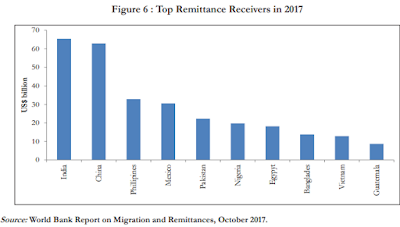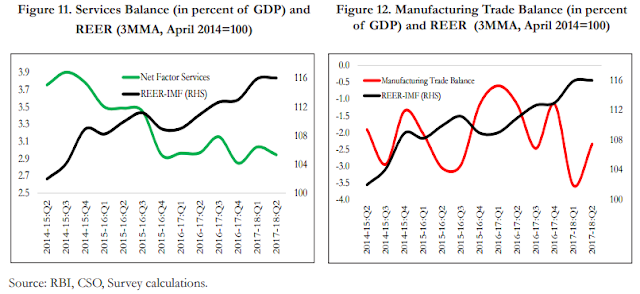Dutch disease of India - Services and Remittances
What is dutch disease?
In my last blog post I had mentioned about Dutch disease type of effect present in India due to services earnings and foreign inward remittances. I had mentioned,
In my last blog post I had mentioned about Dutch disease type of effect present in India due to services earnings and foreign inward remittances. I had mentioned,
I have reasons to believe that Indian merchandise exports suffer because of unnecessarily strong rupee. The rupee strength is derived from the fact that we are accumulating reserves due to net inward flow of foreign currency through capital inflows, services earnings, and huge remittances from expats abroad. We maintain a significant current account deficit on merchandise trade (roughly 200 Billion USD), and if other inflows were absent, this deficit would have ideally weakened the rupee. A strong service sector earnings, with high remittances flowing in, when clubbed with other capital flows into India, buoy the rupee up and make the manufacturing sector uncompetitive. It is kind of dutch disease syndrome where the remittances and services are harming manufacturing competitiveness. Roughly, I feel that we are at a disadvantage of around 10 to 15% of adverse currency strength from the merchandise exports point of view. The approximate level for competitive merchandise exports from India would be around Rs 75 to 80 per USD against the current level of Rs 63 to 68 per USD. On this point alone I would go with Mnuchin and say that a weaker rupee would be welcome for India's manufacturing sector.
This needs some elaboration.
The mechanism of dutch disease typically works this way:
Stage 1: Massive increase in exports revenue due to one sector leading to temporary appreciation in real exchange rate. (mostly sudden discovery or exploitation of natural resources such as oil/gas/minerals in classical cases). In India, similar effect is being created by a combination of high capital inflows (FDI, remittances), and earnings from a booming services sector. The following figures are self explanatory. This is leading to appreciation in real exchange rate in India.
 |
| India receives highest remittance income (almost 70 Billion USD) |
 |
| Services exports growth is positive on high base |
 |
| CAD composition |
 |
| Net capital inflows recently |
Stage 2 Effect 1: This adverse exchange rate makes exports from other sectors (non booming sectors such as manufacturing) uncompetitive in world markets
 |
| REER for India - on the way up |
Stage 2 Effect 2: Assuming no intervention in exchange rate by the government, inflation might kick in due to higher spending/consumption ability of the population that earns through the boom sectors (services, remittances). This effect is similar to loose fiscal policy in a way.
Stage 3: Wages decline in real terms in other sectors (manufacturing), input costs go up (inflation effect), selling price across borders go down for non boom sectors (such as manufacturing) and they start to recede from world market. They produce less and employment in this sector starts falling, as shown in figure below.
 |
| Non oil, non gold manufacturing exports growth - Source: Economic survey 2018 |

The effect of dutch disease may spread further through two mechanisms
1. Spending - When a software engineer, or a recipient of Dubai money decides to spend, it pushes up the prices in the market for existing goods. A software engineer in Bangalore hardly haggles with the vegetable vendor, or flinches while paying 150 rupees for a haircut. This behaviour effects a normal Bangalorean living with normal non software wages or a retired pensioner. (with the automation and AI coming in, things might change for normal software engineers in future)
2. Resource movement - When booming sector (services) share factors (labour, bank loans) with non booming sector (manufacturing), the resources may start moving from non boom to booming sector. Anecdotally, I had moved from a product manufacturing company during 2006 to a services company doing engineering analysis for this very reason: the booming sector paid better.
Apart from this, there is also a price and wage increase in non-tradable sectors. Imagine a software engineer paying more for a haircut or vegetables in Bangalore. The behaviour of software engineer would affect a retiree who might be surviving on his pension. Ideally, this phenomenon should bring more barbers and vegetable vendors into the market, and it does, leading to wage increase in the remaining labour pool. It might not work in that simple a way, but overall, when people have buying power due to booming earnings, it does affect the local economy.
For India, additionally, I believe that we are facing acute shortage of trained manpower in the manufacturing sector due to a void in the vocational training programs. This is an additional drag factor. The skill India movement therefore needs more encouraging push and generous policy support.
To sum up, I hazard a guess that India is facing a situation where our manufacturing sector is facing Dutch disease due to strong currency arising out of services and remittances on one hand, and wage increase and skill shortage on the other hand.
We need to overcome this issue through clever means. I shall discuss the same in a future post.
Links for more reading:
Comments
Post a Comment
Comments are moderated. Your comment will be online shortly. Kindly excuse the lag